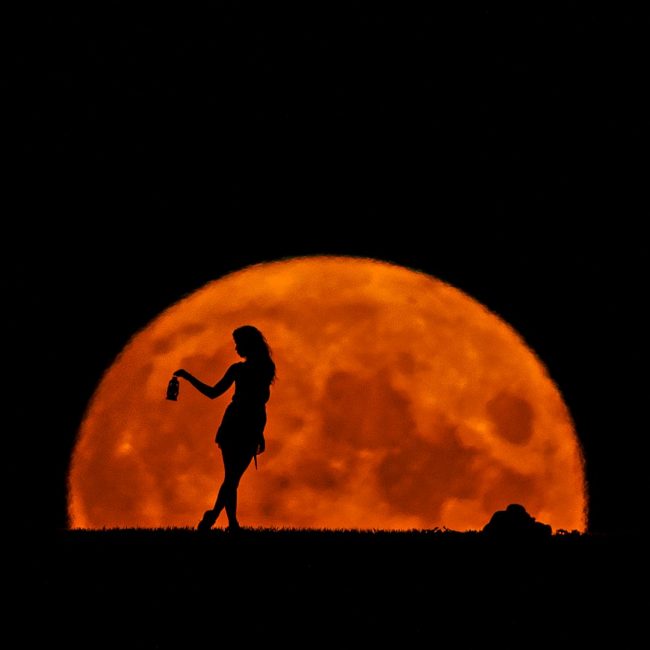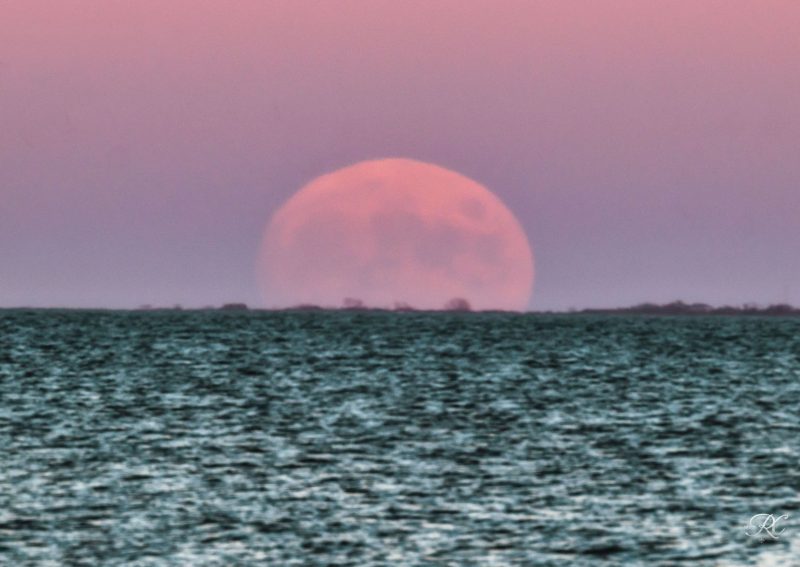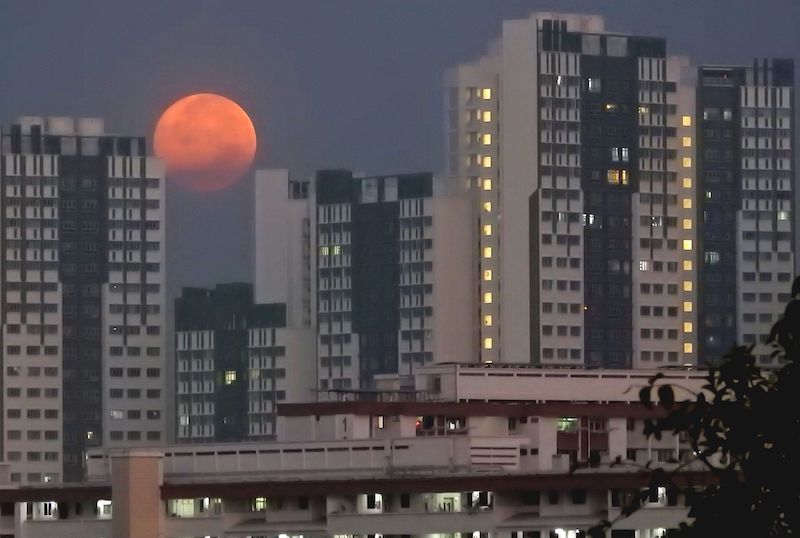
In the Northern Hemisphere, and especially here in North America, we often refer to full moons by special names. Some almanacs assign full moon names by the month. Other almanacs like to reference full moons relative to seasonal markers, as defined by equinoxes and solstices. Is one way better than the other? No. Both have their roots in folklore. Below, we list full moon names that are commonly used in North America. Most of these names were derived from Old English and/or Native American sources. We list them first by the month, and then by the season. Around the middle of this post, we talk about Blue Moons. Toward the bottom, we have a word about moon names in the Southern Hemisphere.
North American full moon names by month
January: Wolf Moon, Old Moon, Moon After Yule
February: Snow Moon, Hunger Moon
March: Sap Moon, Crow Moon, Lenten Moon
April: Grass Moon, Egg Moon, Pink Moon
May: Flower Moon, Planting Moon, Milk Moon
June: Rose Moon, Flower Moon, Strawberry Moon
July: Buck Moon, Thunder Moon, Hay Moon
August: Green Corn Moon, Grain Moon
September: Fruit Moon, Harvest Moon
October: Harvest Moon, Hunter’s Moon
November: Hunter’s Moon, Frosty Moon, Beaver Moon
December: Cold Moon, Moon Before Yule, Long Night Moon
About once every 19 years, February has no full moon at all. The last time that happened was in 2018. Read more: Why no full moon in February 2018?

North American full moon names by season
After the winter solstice:
Old Moon, or Moon After Yule
Snow Moon, Hunger Moon, or Wolf Moon
Sap Moon, Crow Moon or Lenten Moon
After the spring equinox:
Grass Moon, or Egg Moon
Planting Moon, or Milk Moon
Rose Moon, Flower Moon, or Strawberry Moon
After the summer solstice:
Thunder Moon, or Hay Moon
Green Corn Moon, or Grain Moon
Fruit Moon, or Harvest Moon
After the autumnal equinox:
Harvest Moon, or Hunter’s Moon
Hunter’s Moon, Frosty Moon, or Beaver Moon
Moon Before Yule, or Long Night Moon

Moon names in the Southern Hemisphere?
As you probably know, the seasons for Earth’s two hemispheres are opposite. When it’s summer in the Northern Hemisphere, it’s winter in the Southern Hemisphere, and so on. When we originally published this article, we suggested that the full moon names might be likewise reversed. For example, the Green Corn Moon or Grain Moon – moon name for the August full moon in North American skylore – might work for the February full moon in the Southern Hemisphere.
But assigning full moon names to moons in the Southern Hemisphere in that way – by flipping the names around to match the seasons – doesn’t really work. For example, our name for January’s full moon in North American skylore is often called the Wolf Moon. You wouldn’t expect a Wolf Moon for the Southern Hemisphere, because what most of us think of as a “wolf” – a gray wolf, canis lupus, isn’t native to the Southern Hemisphere.
We asked several EarthSky friends in the Southern Hemisphere if they knew of full moon names for that part of the world. They all said no. We did see some full moon names for the large island of New Guinea, near Australia, at the website LunarPhasePro.com, but we have no idea if those names are still in use today, or if they come from historical records. Check them out if you’re interested!

What about Blue Moons?
Blue Moons are a special case, whether they come by the month or by the season. Sky watchers in recent years have come to recognize both calendar-month and seasonal Blue Moons.
Calendar-month Blue Moons happen when two full moons fall within a single calendar month. The second of the month’s two full moons is popularly called a Blue Moon. These sorts of Blue Moons happen seven times in every 19 years. In a year where February has no full moon at all, as in the year 2018, you can have two full moons in January and two full moons in March: two Blue Moons in single year.
Let’s take a look at the 8 calendar-month Blue-Moons in the present 19-year Metonic cycle:
1. March 31, 2018
2. October 31, 2020
3. August 31, 2023
4. May 31, 2026
5. December 31, 2028
6. September 30, 2031
7. July 31, 2034
8. January 31, 2037
Seasonal Blue Moons happen seven times in 19 years, too. There are usually three full moons between an equinox and a solstice, or vice versa. But sometimes four full moons fall in a single season. In that case, the third of a season’s four full moons is the Blue Moon. The last Blue Moon by this definition happened on May 18, 2019. The 7 seasonal Blue Moons in the current 19-year lunar cycle are:
1) May 18, 2019
2) August 22, 2021
3) August 19, 2024
4) May 20, 2027
5) August 24, 2029
6) August 21, 2032
7) May 22, 2035
Possible to have only 2 full moons in a single season?

Bottom line: North American full moon names, listed first by month and then by season.
Read more: More comprehensive list of full moon names
Read more: 4 keys to understanding moon phases
The post Full moon names by month and by season first appeared on EarthSky.
from EarthSky https://ift.tt/oGq7fXs

In the Northern Hemisphere, and especially here in North America, we often refer to full moons by special names. Some almanacs assign full moon names by the month. Other almanacs like to reference full moons relative to seasonal markers, as defined by equinoxes and solstices. Is one way better than the other? No. Both have their roots in folklore. Below, we list full moon names that are commonly used in North America. Most of these names were derived from Old English and/or Native American sources. We list them first by the month, and then by the season. Around the middle of this post, we talk about Blue Moons. Toward the bottom, we have a word about moon names in the Southern Hemisphere.
North American full moon names by month
January: Wolf Moon, Old Moon, Moon After Yule
February: Snow Moon, Hunger Moon
March: Sap Moon, Crow Moon, Lenten Moon
April: Grass Moon, Egg Moon, Pink Moon
May: Flower Moon, Planting Moon, Milk Moon
June: Rose Moon, Flower Moon, Strawberry Moon
July: Buck Moon, Thunder Moon, Hay Moon
August: Green Corn Moon, Grain Moon
September: Fruit Moon, Harvest Moon
October: Harvest Moon, Hunter’s Moon
November: Hunter’s Moon, Frosty Moon, Beaver Moon
December: Cold Moon, Moon Before Yule, Long Night Moon
About once every 19 years, February has no full moon at all. The last time that happened was in 2018. Read more: Why no full moon in February 2018?

North American full moon names by season
After the winter solstice:
Old Moon, or Moon After Yule
Snow Moon, Hunger Moon, or Wolf Moon
Sap Moon, Crow Moon or Lenten Moon
After the spring equinox:
Grass Moon, or Egg Moon
Planting Moon, or Milk Moon
Rose Moon, Flower Moon, or Strawberry Moon
After the summer solstice:
Thunder Moon, or Hay Moon
Green Corn Moon, or Grain Moon
Fruit Moon, or Harvest Moon
After the autumnal equinox:
Harvest Moon, or Hunter’s Moon
Hunter’s Moon, Frosty Moon, or Beaver Moon
Moon Before Yule, or Long Night Moon

Moon names in the Southern Hemisphere?
As you probably know, the seasons for Earth’s two hemispheres are opposite. When it’s summer in the Northern Hemisphere, it’s winter in the Southern Hemisphere, and so on. When we originally published this article, we suggested that the full moon names might be likewise reversed. For example, the Green Corn Moon or Grain Moon – moon name for the August full moon in North American skylore – might work for the February full moon in the Southern Hemisphere.
But assigning full moon names to moons in the Southern Hemisphere in that way – by flipping the names around to match the seasons – doesn’t really work. For example, our name for January’s full moon in North American skylore is often called the Wolf Moon. You wouldn’t expect a Wolf Moon for the Southern Hemisphere, because what most of us think of as a “wolf” – a gray wolf, canis lupus, isn’t native to the Southern Hemisphere.
We asked several EarthSky friends in the Southern Hemisphere if they knew of full moon names for that part of the world. They all said no. We did see some full moon names for the large island of New Guinea, near Australia, at the website LunarPhasePro.com, but we have no idea if those names are still in use today, or if they come from historical records. Check them out if you’re interested!

What about Blue Moons?
Blue Moons are a special case, whether they come by the month or by the season. Sky watchers in recent years have come to recognize both calendar-month and seasonal Blue Moons.
Calendar-month Blue Moons happen when two full moons fall within a single calendar month. The second of the month’s two full moons is popularly called a Blue Moon. These sorts of Blue Moons happen seven times in every 19 years. In a year where February has no full moon at all, as in the year 2018, you can have two full moons in January and two full moons in March: two Blue Moons in single year.
Let’s take a look at the 8 calendar-month Blue-Moons in the present 19-year Metonic cycle:
1. March 31, 2018
2. October 31, 2020
3. August 31, 2023
4. May 31, 2026
5. December 31, 2028
6. September 30, 2031
7. July 31, 2034
8. January 31, 2037
Seasonal Blue Moons happen seven times in 19 years, too. There are usually three full moons between an equinox and a solstice, or vice versa. But sometimes four full moons fall in a single season. In that case, the third of a season’s four full moons is the Blue Moon. The last Blue Moon by this definition happened on May 18, 2019. The 7 seasonal Blue Moons in the current 19-year lunar cycle are:
1) May 18, 2019
2) August 22, 2021
3) August 19, 2024
4) May 20, 2027
5) August 24, 2029
6) August 21, 2032
7) May 22, 2035
Possible to have only 2 full moons in a single season?

Bottom line: North American full moon names, listed first by month and then by season.
Read more: More comprehensive list of full moon names
Read more: 4 keys to understanding moon phases
The post Full moon names by month and by season first appeared on EarthSky.
from EarthSky https://ift.tt/oGq7fXs

Aucun commentaire:
Enregistrer un commentaire